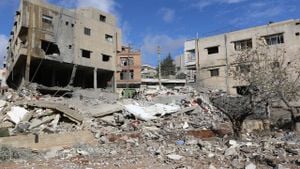Winnipeg is shaken by the recent police-involved shooting incident, which has raised eyebrows and sparked discussions about police protocol and the broader issues surrounding crime and mental health. On the evening of November 24, 2024, dramatic events unfolded at the Unicity shopping center, located in the city’s far west. Winnipeg police responded to calls about an officer who had been viciously stabbed and ended up fatally shooting the suspect involved.
The suspect, Jordan Charlie, 24, had just recently been released after serving time for prior assault charges. Reports say he stabbed one of the officers involved, leading to the police reacting decisively. Video footage circulating online captured the chaotic scene, showing police urging the suspect to drop any potentially dangerous objects before engaging.
Following the stabbing, Officer Josh Taylor was transported to the hospital and was reported to be recovering. Meanwhile, the suspect was also provided medical attention but was later pronounced dead at the hospital, igniting the firestorm of investigation and legal scrutiny. This incident has spurred the Independent Investigation Unit (IIU) to conduct its own investigation to assess the actions of the police during the encounter.
Kelly Gorkoff, the chair of the University of Winnipeg’s criminal justice department, opined about the actions taken by the officers during the confrontation. Gorkoff noted, “Police need to think about what’s the best outcome and react accordingly. It seems as though they handled the situation more reactively than proactively.” She underscored the importance of officers being trained to assess, plan, and then act—rather than simply reacting under pressure. While she acknowledges the difficulty of police work, she also emphasizes the necessity for officers to remain unwaveringly cautious when detaining suspects, even under perilous situations.
The Acting Chief of Winnipeg Police Service, Art Stannard, offered his perspective following the shooting, indicating it was clear the actions of the officers were reactions to immediate threats. He affirmed the dedication of the officers, who, according to him, did not take the decision to use lethal force lightly. “These members are dedicated police officers, officers who did not ever want to take a life,” Stannard shared.
Critics argue, nevertheless, whether the police actions constituted excessive force. Gorkoff entered the foray of this debate, saying, “The idea of rapid-fire the way it was shown [in the videos]: they shot like 10 times. The intention wasn’t to get the individual under control; it seemed more like shoot to kill.” While the footage may arouse concern, the IIU has requested the public maintain patience and allow the investigation to proceed without rushing to conclusions.
Onlookers at the scene detailed their shock and concern, with many shoppers caught up by the sudden violence at the usually tranquil shopping center. One bystander said, “It’s unsettling to see something like this happen here. It’s supposed to be a safe place for families and people out shopping.” Public reaction has been mixed, with some applauding police actions, believing they were justified under the circumstances, and others expressing concern about training and policing standards.
This latest incident has prompted local politicians, including Manitoba Premier Wab Kinew, to make statements almost immediately. Kinew extended condolences to the family of the deceased and expressed sympathy for law enforcement, emphasizing, “When we’re thinking about the holidays and people going to the malls and shopping areas around the province, safety is of utmost importance.”
City Councillor Markus Chambers, who chairs the Winnipeg Police Board, addressed the potential need for police body cameras. He noted, “Body-worn cameras likely wouldn’t have prevented this incident, but they offer accountability and transparency as we assess such situations.” With recent moves toward implementing body cameras among the RCMP, increased echo chambers are being created around the need for similar actions within the Winnipeg Police Service.
This is not the first time the community has grappled with issues of systemic violence and policing. Jordan Charlie, the man at the center of the recent events, had previously encountered legal troubles. Born and raised within the residential school legacy, he reportedly suffered from mental health issues, and his recent stints with the law were marred by drug addiction and violent outbursts. His troubled upbringing included time spent homeless, and the struggle to regain his footing and return to his community was ever-present.
Rewind to 2019, when Charlie was sentenced to four-and-a-half years for stabbing another individual before engaging with law enforcement aggressively on multiple prior occasions, including attacks on corrections officers. Just last year, after being released from Stony Mountain Institution, he stabbed another security guard at the Health Sciences Centre following his release. Despite repeated warnings by officials about his violent tendencies, little seemed to deter Charlie from re-engaging with criminal behavior.
The police shooting has brought the underlying issues of mental health and systemic responses back under public scrutiny. Advocates for mental health reform have now drawn attention to Charlie’s story, using it as evidence for wider systemic failures in addressing the needs of those suffering from mental illness.
Overall, the incident at the Unicity shopping center raises several significant issues: public safety, the responsibilities of law enforcement, mental health challenges, and the continued struggles faced by individuals like Charlie. It’s clear more discussions are needed about how police can interact with those who may be mentally unwell without resorting to lethal means. This narrative will undoubtedly continue to evolve as investigations proceed and communities demand answers.
For now, Winnipeg grapples with the realities of life—and death—on the streets of its neighborhoods and the overwhelming questions raised following police involvement against the backdrop of social service shortcomings. The community must reflect and evaluate how it individually approaches these crises, ensuring lessons are learned from incidents to prevent future tragedies.



